Financial Accounting Report: Liquidation Analysis of Australian Firms
VerifiedAdded on 2020/03/02
|12
|2917
|91
Report
AI Summary
This financial accounting report provides an in-depth analysis of company liquidations, focusing on prominent cases like HIH Insurance, OneTel, and ABC Learning in Australia. The report examines the key factors contributing to these liquidations, including immense growth of liabilities, financial reporting issues, inadequate planning, and concealment of secrets. It delves into the specific events that led to the downfall of each company, such as future claims, ineffective pricing strategies, and weak corporate governance. The report also highlights the importance of proper financial reporting and internal control mechanisms. By studying these cases, the report aims to provide insights into the complexities of financial management and the critical role of sound business practices in preventing corporate failures. The analysis covers the financial reporting issues, events leading to liquidation, and the ultimate consequences faced by these companies. The report emphasizes the significance of effective risk management and ethical conduct in the business environment.

FINANCIAL ACCOUNTING
Paraphrase This Document
Need a fresh take? Get an instant paraphrase of this document with our AI Paraphraser
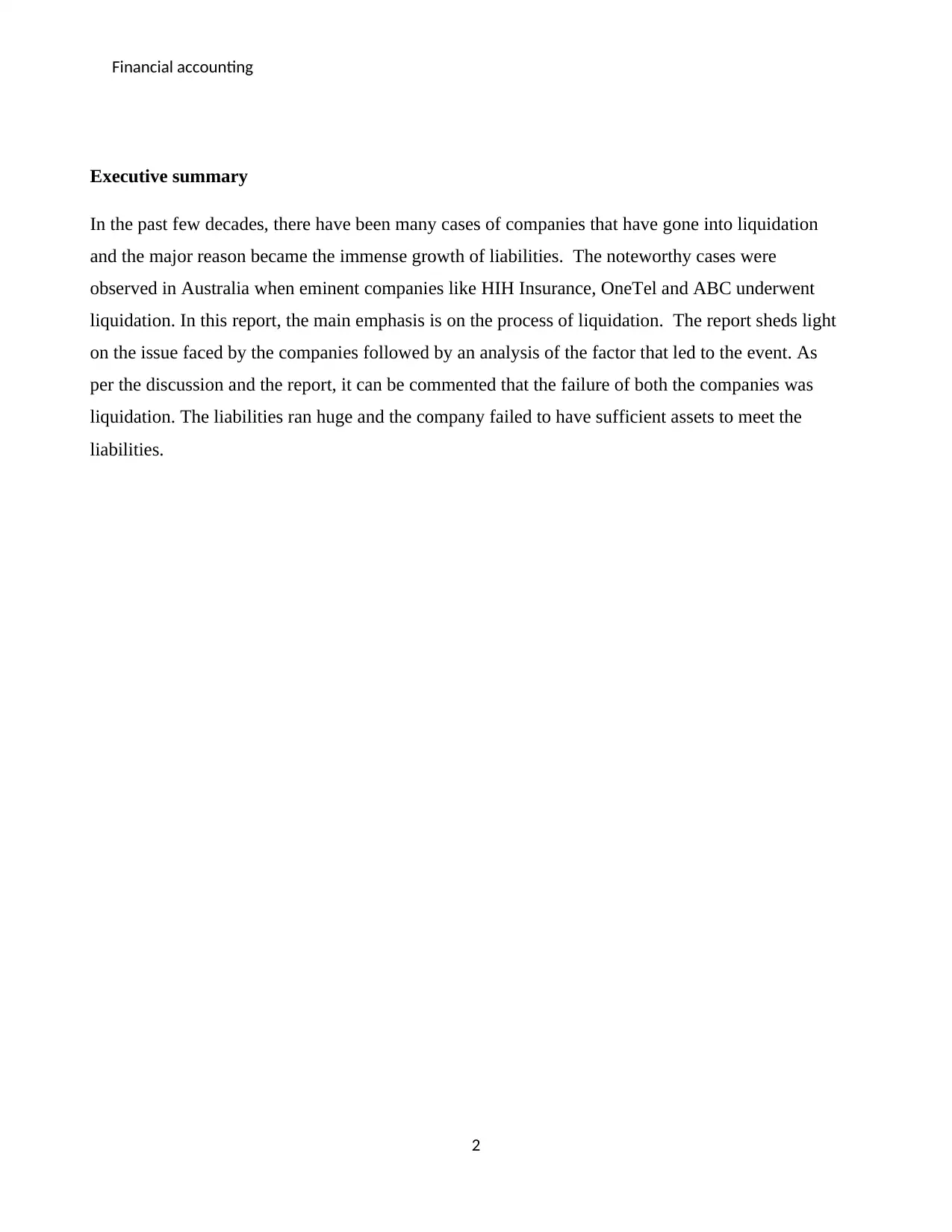
Financial accounting
Executive summary
In the past few decades, there have been many cases of companies that have gone into liquidation
and the major reason became the immense growth of liabilities. The noteworthy cases were
observed in Australia when eminent companies like HIH Insurance, OneTel and ABC underwent
liquidation. In this report, the main emphasis is on the process of liquidation. The report sheds light
on the issue faced by the companies followed by an analysis of the factor that led to the event. As
per the discussion and the report, it can be commented that the failure of both the companies was
liquidation. The liabilities ran huge and the company failed to have sufficient assets to meet the
liabilities.
2
Executive summary
In the past few decades, there have been many cases of companies that have gone into liquidation
and the major reason became the immense growth of liabilities. The noteworthy cases were
observed in Australia when eminent companies like HIH Insurance, OneTel and ABC underwent
liquidation. In this report, the main emphasis is on the process of liquidation. The report sheds light
on the issue faced by the companies followed by an analysis of the factor that led to the event. As
per the discussion and the report, it can be commented that the failure of both the companies was
liquidation. The liabilities ran huge and the company failed to have sufficient assets to meet the
liabilities.
2
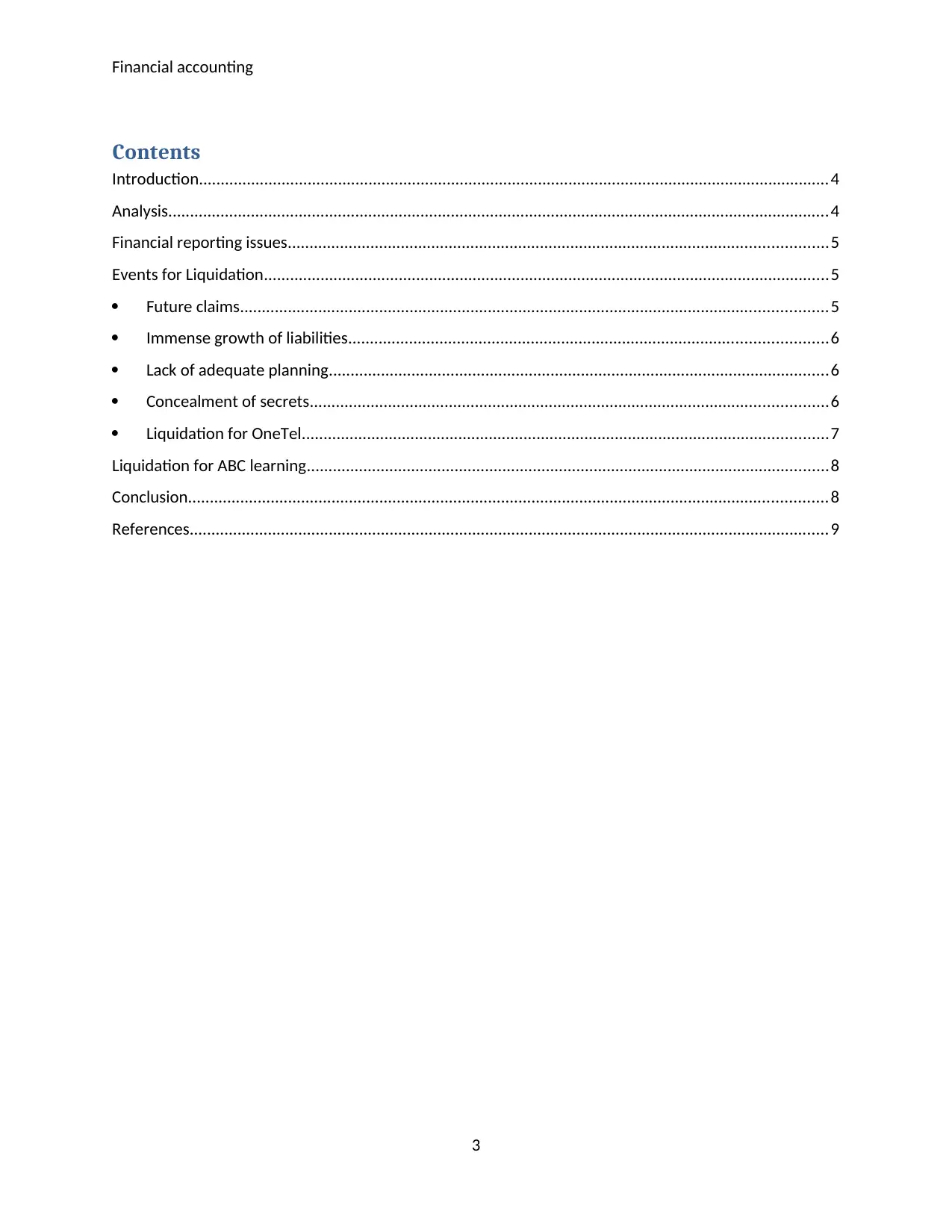
Financial accounting
Contents
Introduction.................................................................................................................................................4
Analysis........................................................................................................................................................4
Financial reporting issues............................................................................................................................5
Events for Liquidation..................................................................................................................................5
Future claims.......................................................................................................................................5
Immense growth of liabilities..............................................................................................................6
Lack of adequate planning...................................................................................................................6
Concealment of secrets.......................................................................................................................6
Liquidation for OneTel.........................................................................................................................7
Liquidation for ABC learning........................................................................................................................8
Conclusion...................................................................................................................................................8
References...................................................................................................................................................9
3
Contents
Introduction.................................................................................................................................................4
Analysis........................................................................................................................................................4
Financial reporting issues............................................................................................................................5
Events for Liquidation..................................................................................................................................5
Future claims.......................................................................................................................................5
Immense growth of liabilities..............................................................................................................6
Lack of adequate planning...................................................................................................................6
Concealment of secrets.......................................................................................................................6
Liquidation for OneTel.........................................................................................................................7
Liquidation for ABC learning........................................................................................................................8
Conclusion...................................................................................................................................................8
References...................................................................................................................................................9
3
⊘ This is a preview!⊘
Do you want full access?
Subscribe today to unlock all pages.

Trusted by 1+ million students worldwide
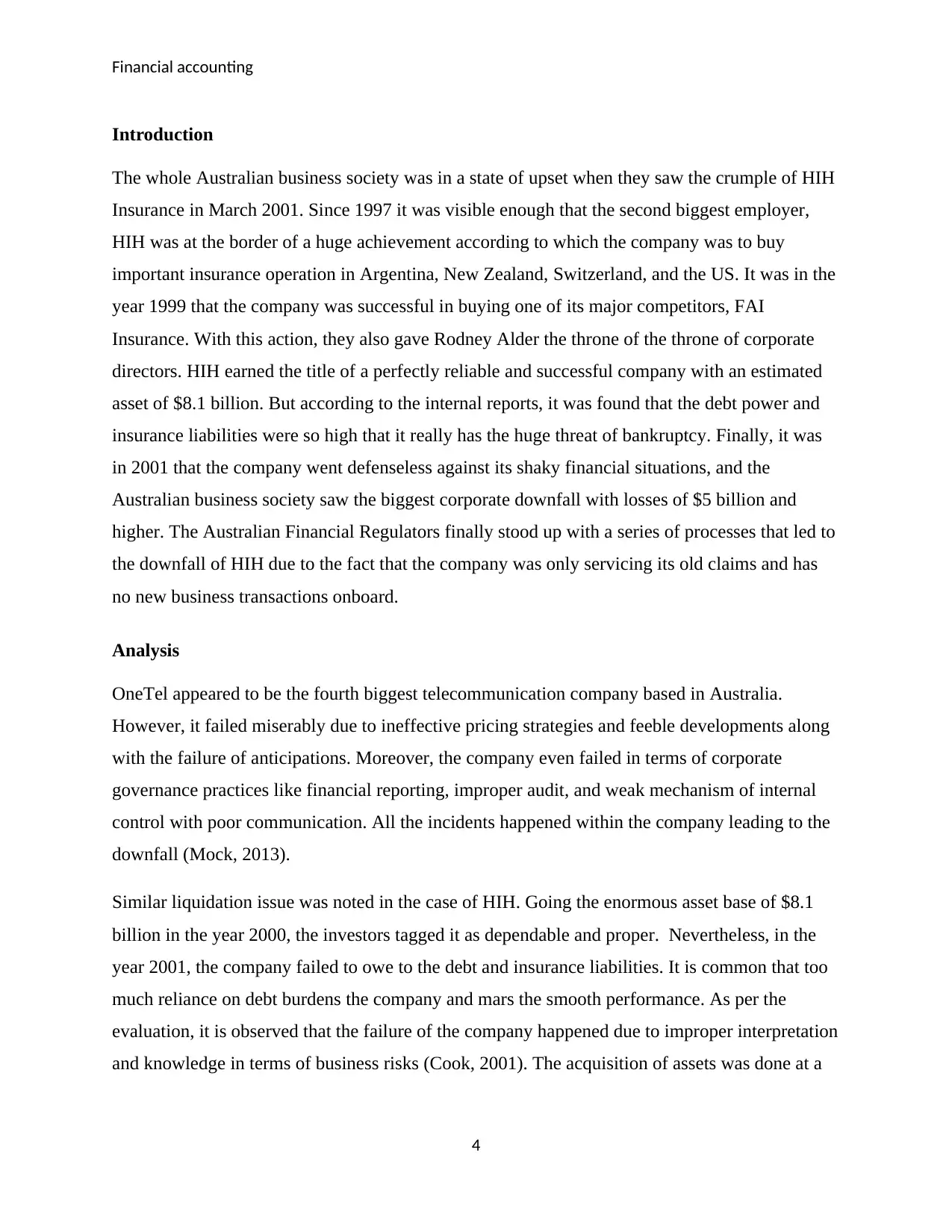
Financial accounting
Introduction
The whole Australian business society was in a state of upset when they saw the crumple of HIH
Insurance in March 2001. Since 1997 it was visible enough that the second biggest employer,
HIH was at the border of a huge achievement according to which the company was to buy
important insurance operation in Argentina, New Zealand, Switzerland, and the US. It was in the
year 1999 that the company was successful in buying one of its major competitors, FAI
Insurance. With this action, they also gave Rodney Alder the throne of the throne of corporate
directors. HIH earned the title of a perfectly reliable and successful company with an estimated
asset of $8.1 billion. But according to the internal reports, it was found that the debt power and
insurance liabilities were so high that it really has the huge threat of bankruptcy. Finally, it was
in 2001 that the company went defenseless against its shaky financial situations, and the
Australian business society saw the biggest corporate downfall with losses of $5 billion and
higher. The Australian Financial Regulators finally stood up with a series of processes that led to
the downfall of HIH due to the fact that the company was only servicing its old claims and has
no new business transactions onboard.
Analysis
OneTel appeared to be the fourth biggest telecommunication company based in Australia.
However, it failed miserably due to ineffective pricing strategies and feeble developments along
with the failure of anticipations. Moreover, the company even failed in terms of corporate
governance practices like financial reporting, improper audit, and weak mechanism of internal
control with poor communication. All the incidents happened within the company leading to the
downfall (Mock, 2013).
Similar liquidation issue was noted in the case of HIH. Going the enormous asset base of $8.1
billion in the year 2000, the investors tagged it as dependable and proper. Nevertheless, in the
year 2001, the company failed to owe to the debt and insurance liabilities. It is common that too
much reliance on debt burdens the company and mars the smooth performance. As per the
evaluation, it is observed that the failure of the company happened due to improper interpretation
and knowledge in terms of business risks (Cook, 2001). The acquisition of assets was done at a
4
Introduction
The whole Australian business society was in a state of upset when they saw the crumple of HIH
Insurance in March 2001. Since 1997 it was visible enough that the second biggest employer,
HIH was at the border of a huge achievement according to which the company was to buy
important insurance operation in Argentina, New Zealand, Switzerland, and the US. It was in the
year 1999 that the company was successful in buying one of its major competitors, FAI
Insurance. With this action, they also gave Rodney Alder the throne of the throne of corporate
directors. HIH earned the title of a perfectly reliable and successful company with an estimated
asset of $8.1 billion. But according to the internal reports, it was found that the debt power and
insurance liabilities were so high that it really has the huge threat of bankruptcy. Finally, it was
in 2001 that the company went defenseless against its shaky financial situations, and the
Australian business society saw the biggest corporate downfall with losses of $5 billion and
higher. The Australian Financial Regulators finally stood up with a series of processes that led to
the downfall of HIH due to the fact that the company was only servicing its old claims and has
no new business transactions onboard.
Analysis
OneTel appeared to be the fourth biggest telecommunication company based in Australia.
However, it failed miserably due to ineffective pricing strategies and feeble developments along
with the failure of anticipations. Moreover, the company even failed in terms of corporate
governance practices like financial reporting, improper audit, and weak mechanism of internal
control with poor communication. All the incidents happened within the company leading to the
downfall (Mock, 2013).
Similar liquidation issue was noted in the case of HIH. Going the enormous asset base of $8.1
billion in the year 2000, the investors tagged it as dependable and proper. Nevertheless, in the
year 2001, the company failed to owe to the debt and insurance liabilities. It is common that too
much reliance on debt burdens the company and mars the smooth performance. As per the
evaluation, it is observed that the failure of the company happened due to improper interpretation
and knowledge in terms of business risks (Cook, 2001). The acquisition of assets was done at a
4
Paraphrase This Document
Need a fresh take? Get an instant paraphrase of this document with our AI Paraphraser
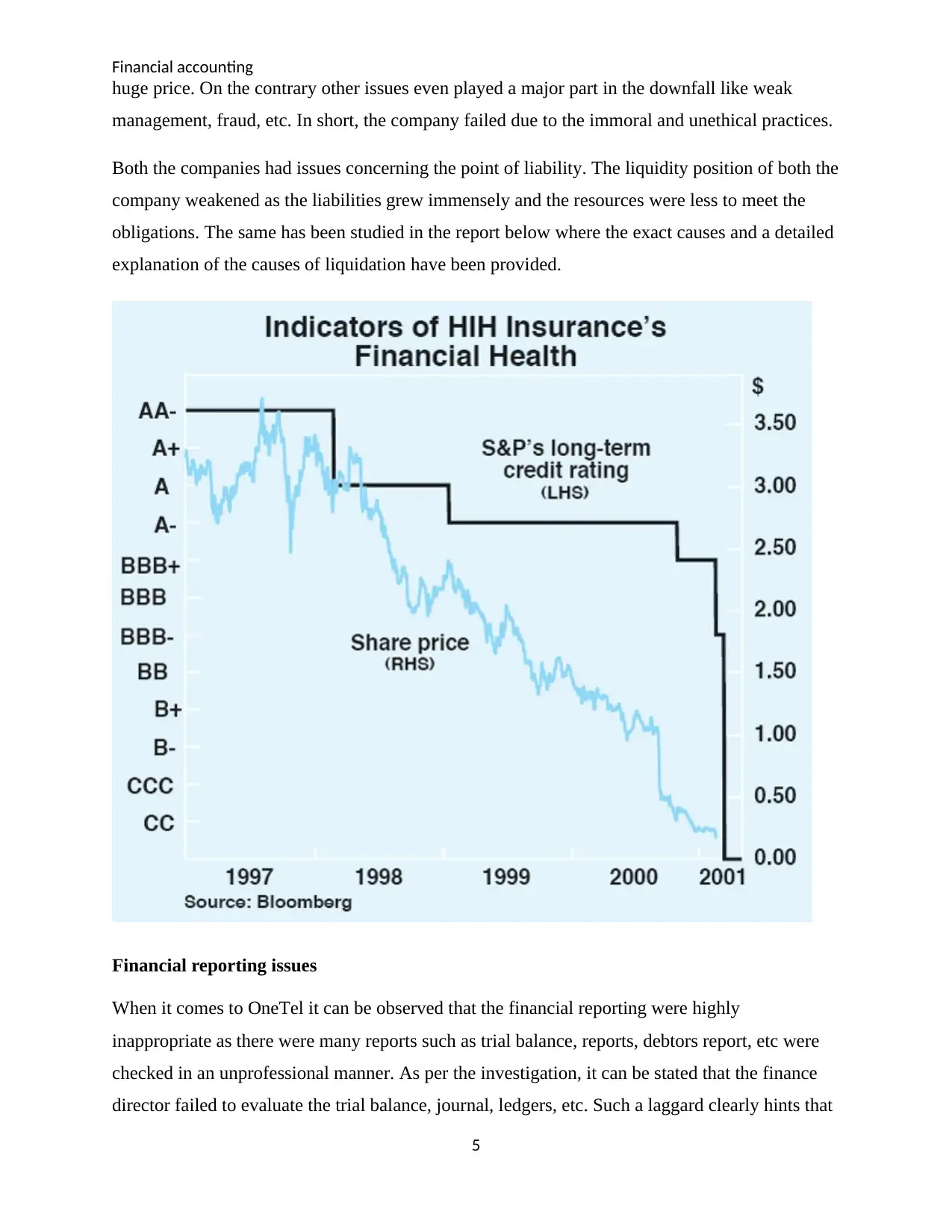
Financial accounting
huge price. On the contrary other issues even played a major part in the downfall like weak
management, fraud, etc. In short, the company failed due to the immoral and unethical practices.
Both the companies had issues concerning the point of liability. The liquidity position of both the
company weakened as the liabilities grew immensely and the resources were less to meet the
obligations. The same has been studied in the report below where the exact causes and a detailed
explanation of the causes of liquidation have been provided.
Financial reporting issues
When it comes to OneTel it can be observed that the financial reporting were highly
inappropriate as there were many reports such as trial balance, reports, debtors report, etc were
checked in an unprofessional manner. As per the investigation, it can be stated that the finance
director failed to evaluate the trial balance, journal, ledgers, etc. Such a laggard clearly hints that
5
huge price. On the contrary other issues even played a major part in the downfall like weak
management, fraud, etc. In short, the company failed due to the immoral and unethical practices.
Both the companies had issues concerning the point of liability. The liquidity position of both the
company weakened as the liabilities grew immensely and the resources were less to meet the
obligations. The same has been studied in the report below where the exact causes and a detailed
explanation of the causes of liquidation have been provided.
Financial reporting issues
When it comes to OneTel it can be observed that the financial reporting were highly
inappropriate as there were many reports such as trial balance, reports, debtors report, etc were
checked in an unprofessional manner. As per the investigation, it can be stated that the finance
director failed to evaluate the trial balance, journal, ledgers, etc. Such a laggard clearly hints that
5
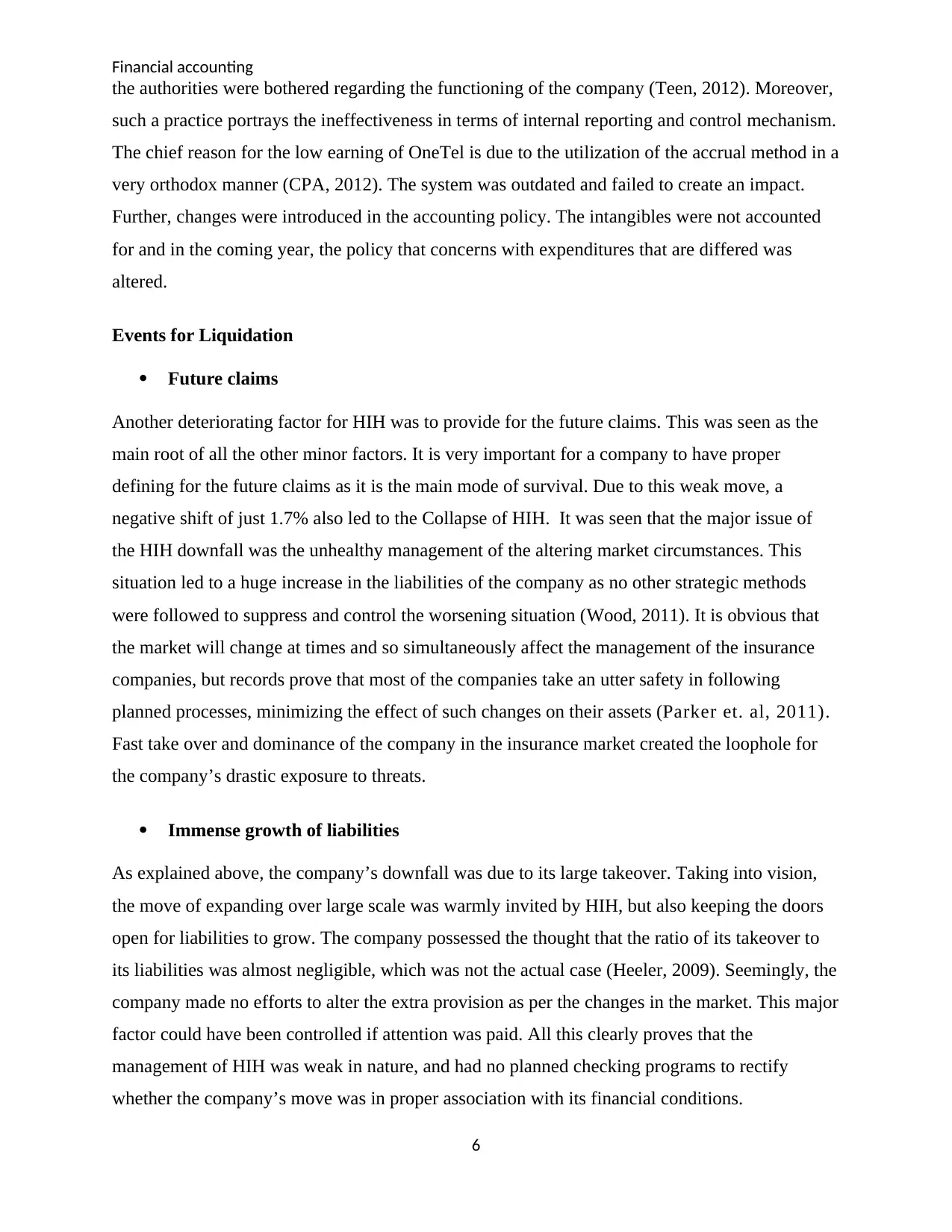
Financial accounting
the authorities were bothered regarding the functioning of the company (Teen, 2012). Moreover,
such a practice portrays the ineffectiveness in terms of internal reporting and control mechanism.
The chief reason for the low earning of OneTel is due to the utilization of the accrual method in a
very orthodox manner (CPA, 2012). The system was outdated and failed to create an impact.
Further, changes were introduced in the accounting policy. The intangibles were not accounted
for and in the coming year, the policy that concerns with expenditures that are differed was
altered.
Events for Liquidation
Future claims
Another deteriorating factor for HIH was to provide for the future claims. This was seen as the
main root of all the other minor factors. It is very important for a company to have proper
defining for the future claims as it is the main mode of survival. Due to this weak move, a
negative shift of just 1.7% also led to the Collapse of HIH. It was seen that the major issue of
the HIH downfall was the unhealthy management of the altering market circumstances. This
situation led to a huge increase in the liabilities of the company as no other strategic methods
were followed to suppress and control the worsening situation (Wood, 2011). It is obvious that
the market will change at times and so simultaneously affect the management of the insurance
companies, but records prove that most of the companies take an utter safety in following
planned processes, minimizing the effect of such changes on their assets (Parker et. al, 2011).
Fast take over and dominance of the company in the insurance market created the loophole for
the company’s drastic exposure to threats.
Immense growth of liabilities
As explained above, the company’s downfall was due to its large takeover. Taking into vision,
the move of expanding over large scale was warmly invited by HIH, but also keeping the doors
open for liabilities to grow. The company possessed the thought that the ratio of its takeover to
its liabilities was almost negligible, which was not the actual case (Heeler, 2009). Seemingly, the
company made no efforts to alter the extra provision as per the changes in the market. This major
factor could have been controlled if attention was paid. All this clearly proves that the
management of HIH was weak in nature, and had no planned checking programs to rectify
whether the company’s move was in proper association with its financial conditions.
6
the authorities were bothered regarding the functioning of the company (Teen, 2012). Moreover,
such a practice portrays the ineffectiveness in terms of internal reporting and control mechanism.
The chief reason for the low earning of OneTel is due to the utilization of the accrual method in a
very orthodox manner (CPA, 2012). The system was outdated and failed to create an impact.
Further, changes were introduced in the accounting policy. The intangibles were not accounted
for and in the coming year, the policy that concerns with expenditures that are differed was
altered.
Events for Liquidation
Future claims
Another deteriorating factor for HIH was to provide for the future claims. This was seen as the
main root of all the other minor factors. It is very important for a company to have proper
defining for the future claims as it is the main mode of survival. Due to this weak move, a
negative shift of just 1.7% also led to the Collapse of HIH. It was seen that the major issue of
the HIH downfall was the unhealthy management of the altering market circumstances. This
situation led to a huge increase in the liabilities of the company as no other strategic methods
were followed to suppress and control the worsening situation (Wood, 2011). It is obvious that
the market will change at times and so simultaneously affect the management of the insurance
companies, but records prove that most of the companies take an utter safety in following
planned processes, minimizing the effect of such changes on their assets (Parker et. al, 2011).
Fast take over and dominance of the company in the insurance market created the loophole for
the company’s drastic exposure to threats.
Immense growth of liabilities
As explained above, the company’s downfall was due to its large takeover. Taking into vision,
the move of expanding over large scale was warmly invited by HIH, but also keeping the doors
open for liabilities to grow. The company possessed the thought that the ratio of its takeover to
its liabilities was almost negligible, which was not the actual case (Heeler, 2009). Seemingly, the
company made no efforts to alter the extra provision as per the changes in the market. This major
factor could have been controlled if attention was paid. All this clearly proves that the
management of HIH was weak in nature, and had no planned checking programs to rectify
whether the company’s move was in proper association with its financial conditions.
6
⊘ This is a preview!⊘
Do you want full access?
Subscribe today to unlock all pages.

Trusted by 1+ million students worldwide
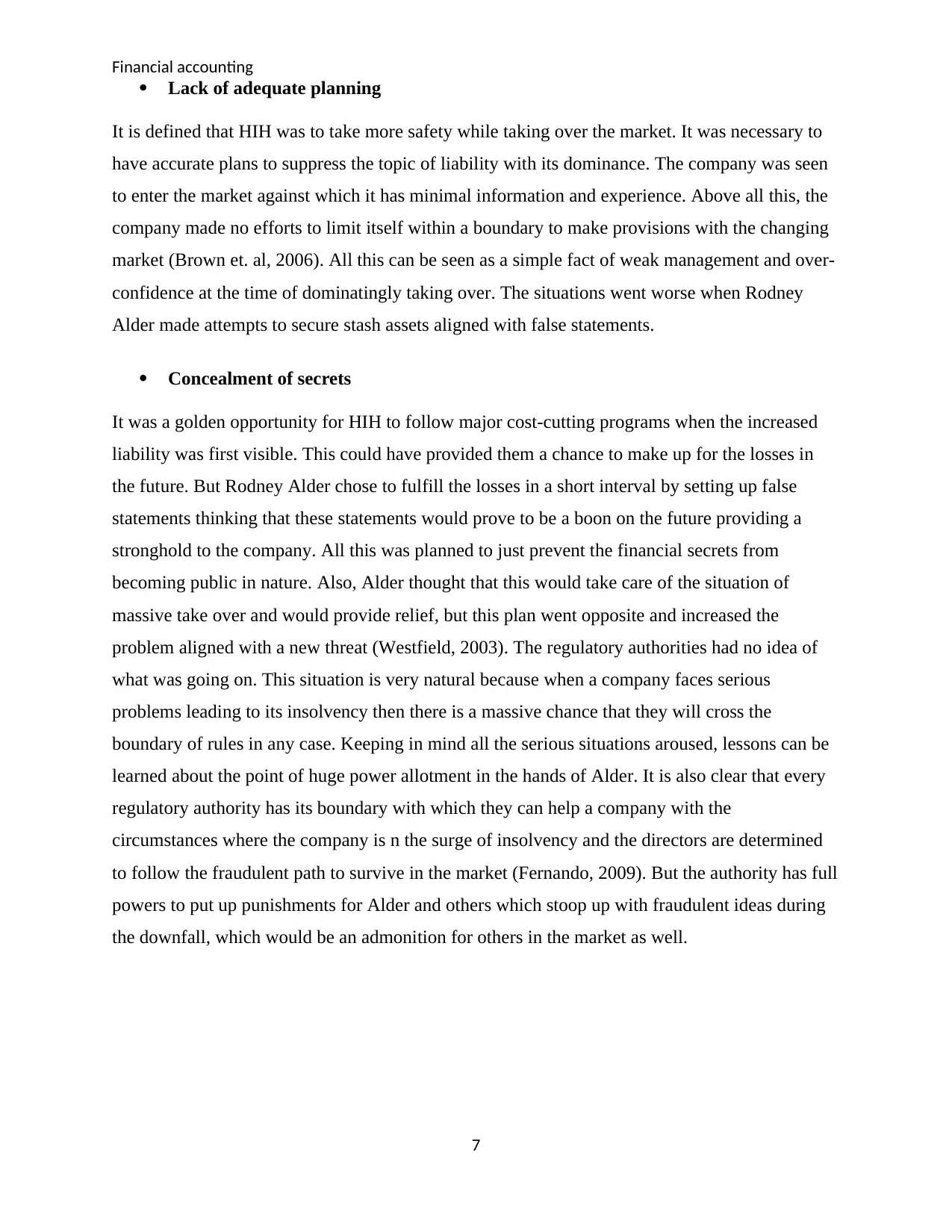
Financial accounting
Lack of adequate planning
It is defined that HIH was to take more safety while taking over the market. It was necessary to
have accurate plans to suppress the topic of liability with its dominance. The company was seen
to enter the market against which it has minimal information and experience. Above all this, the
company made no efforts to limit itself within a boundary to make provisions with the changing
market (Brown et. al, 2006). All this can be seen as a simple fact of weak management and over-
confidence at the time of dominatingly taking over. The situations went worse when Rodney
Alder made attempts to secure stash assets aligned with false statements.
Concealment of secrets
It was a golden opportunity for HIH to follow major cost-cutting programs when the increased
liability was first visible. This could have provided them a chance to make up for the losses in
the future. But Rodney Alder chose to fulfill the losses in a short interval by setting up false
statements thinking that these statements would prove to be a boon on the future providing a
stronghold to the company. All this was planned to just prevent the financial secrets from
becoming public in nature. Also, Alder thought that this would take care of the situation of
massive take over and would provide relief, but this plan went opposite and increased the
problem aligned with a new threat (Westfield, 2003). The regulatory authorities had no idea of
what was going on. This situation is very natural because when a company faces serious
problems leading to its insolvency then there is a massive chance that they will cross the
boundary of rules in any case. Keeping in mind all the serious situations aroused, lessons can be
learned about the point of huge power allotment in the hands of Alder. It is also clear that every
regulatory authority has its boundary with which they can help a company with the
circumstances where the company is n the surge of insolvency and the directors are determined
to follow the fraudulent path to survive in the market (Fernando, 2009). But the authority has full
powers to put up punishments for Alder and others which stoop up with fraudulent ideas during
the downfall, which would be an admonition for others in the market as well.
7
Lack of adequate planning
It is defined that HIH was to take more safety while taking over the market. It was necessary to
have accurate plans to suppress the topic of liability with its dominance. The company was seen
to enter the market against which it has minimal information and experience. Above all this, the
company made no efforts to limit itself within a boundary to make provisions with the changing
market (Brown et. al, 2006). All this can be seen as a simple fact of weak management and over-
confidence at the time of dominatingly taking over. The situations went worse when Rodney
Alder made attempts to secure stash assets aligned with false statements.
Concealment of secrets
It was a golden opportunity for HIH to follow major cost-cutting programs when the increased
liability was first visible. This could have provided them a chance to make up for the losses in
the future. But Rodney Alder chose to fulfill the losses in a short interval by setting up false
statements thinking that these statements would prove to be a boon on the future providing a
stronghold to the company. All this was planned to just prevent the financial secrets from
becoming public in nature. Also, Alder thought that this would take care of the situation of
massive take over and would provide relief, but this plan went opposite and increased the
problem aligned with a new threat (Westfield, 2003). The regulatory authorities had no idea of
what was going on. This situation is very natural because when a company faces serious
problems leading to its insolvency then there is a massive chance that they will cross the
boundary of rules in any case. Keeping in mind all the serious situations aroused, lessons can be
learned about the point of huge power allotment in the hands of Alder. It is also clear that every
regulatory authority has its boundary with which they can help a company with the
circumstances where the company is n the surge of insolvency and the directors are determined
to follow the fraudulent path to survive in the market (Fernando, 2009). But the authority has full
powers to put up punishments for Alder and others which stoop up with fraudulent ideas during
the downfall, which would be an admonition for others in the market as well.
7
Paraphrase This Document
Need a fresh take? Get an instant paraphrase of this document with our AI Paraphraser
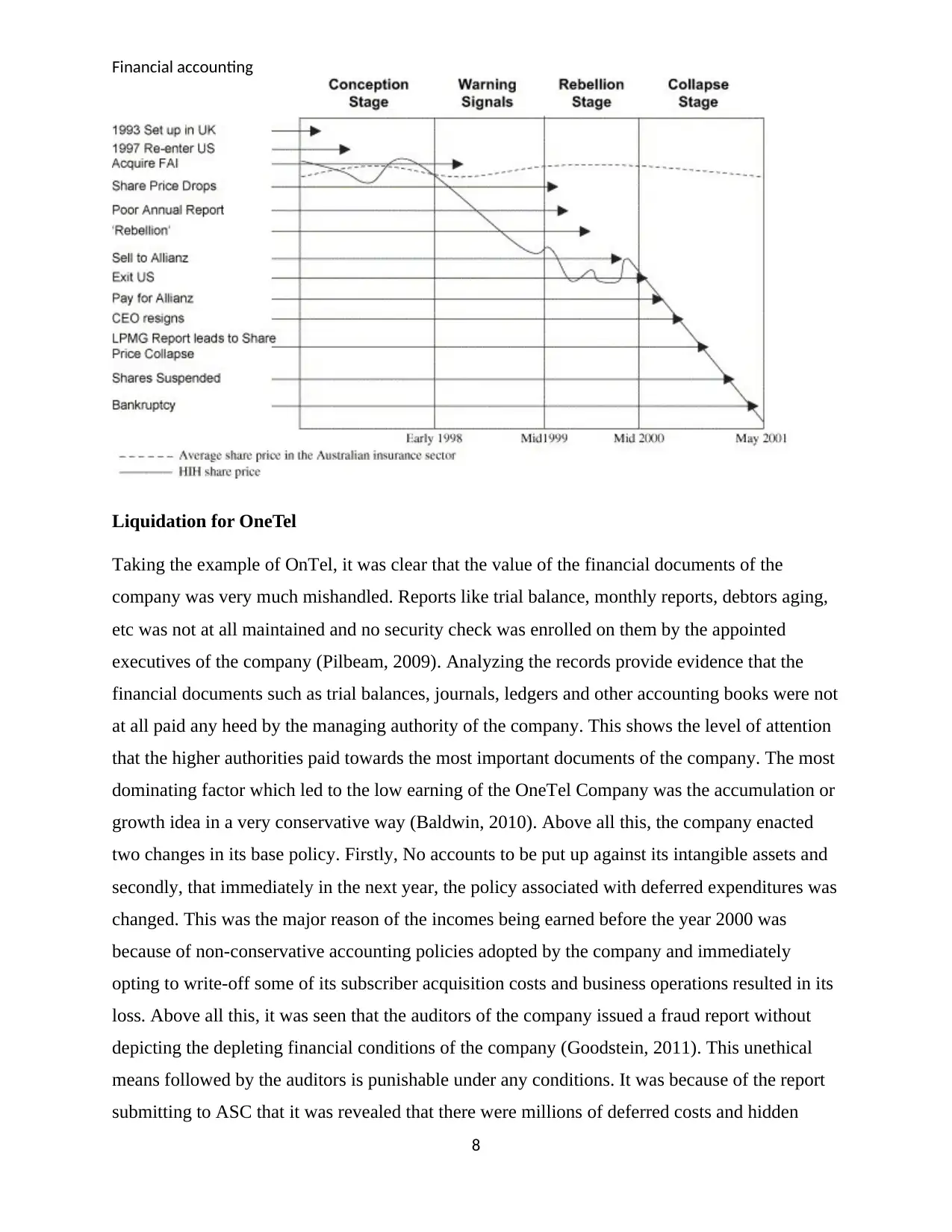
Financial accounting
Liquidation for OneTel
Taking the example of OnTel, it was clear that the value of the financial documents of the
company was very much mishandled. Reports like trial balance, monthly reports, debtors aging,
etc was not at all maintained and no security check was enrolled on them by the appointed
executives of the company (Pilbeam, 2009). Analyzing the records provide evidence that the
financial documents such as trial balances, journals, ledgers and other accounting books were not
at all paid any heed by the managing authority of the company. This shows the level of attention
that the higher authorities paid towards the most important documents of the company. The most
dominating factor which led to the low earning of the OneTel Company was the accumulation or
growth idea in a very conservative way (Baldwin, 2010). Above all this, the company enacted
two changes in its base policy. Firstly, No accounts to be put up against its intangible assets and
secondly, that immediately in the next year, the policy associated with deferred expenditures was
changed. This was the major reason of the incomes being earned before the year 2000 was
because of non-conservative accounting policies adopted by the company and immediately
opting to write-off some of its subscriber acquisition costs and business operations resulted in its
loss. Above all this, it was seen that the auditors of the company issued a fraud report without
depicting the depleting financial conditions of the company (Goodstein, 2011). This unethical
means followed by the auditors is punishable under any conditions. It was because of the report
submitting to ASC that it was revealed that there were millions of deferred costs and hidden
8
Liquidation for OneTel
Taking the example of OnTel, it was clear that the value of the financial documents of the
company was very much mishandled. Reports like trial balance, monthly reports, debtors aging,
etc was not at all maintained and no security check was enrolled on them by the appointed
executives of the company (Pilbeam, 2009). Analyzing the records provide evidence that the
financial documents such as trial balances, journals, ledgers and other accounting books were not
at all paid any heed by the managing authority of the company. This shows the level of attention
that the higher authorities paid towards the most important documents of the company. The most
dominating factor which led to the low earning of the OneTel Company was the accumulation or
growth idea in a very conservative way (Baldwin, 2010). Above all this, the company enacted
two changes in its base policy. Firstly, No accounts to be put up against its intangible assets and
secondly, that immediately in the next year, the policy associated with deferred expenditures was
changed. This was the major reason of the incomes being earned before the year 2000 was
because of non-conservative accounting policies adopted by the company and immediately
opting to write-off some of its subscriber acquisition costs and business operations resulted in its
loss. Above all this, it was seen that the auditors of the company issued a fraud report without
depicting the depleting financial conditions of the company (Goodstein, 2011). This unethical
means followed by the auditors is punishable under any conditions. It was because of the report
submitting to ASC that it was revealed that there were millions of deferred costs and hidden
8
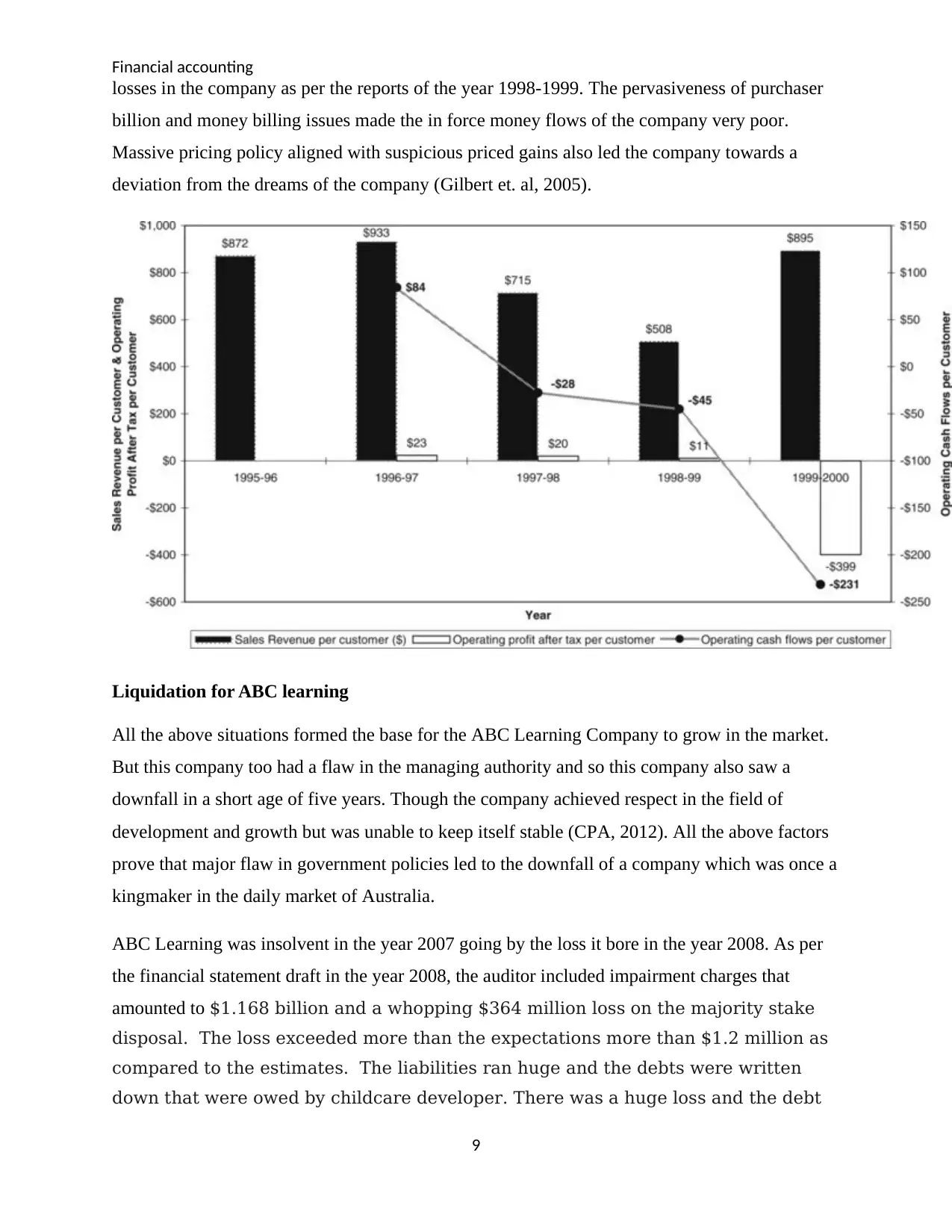
Financial accounting
losses in the company as per the reports of the year 1998-1999. The pervasiveness of purchaser
billion and money billing issues made the in force money flows of the company very poor.
Massive pricing policy aligned with suspicious priced gains also led the company towards a
deviation from the dreams of the company (Gilbert et. al, 2005).
Liquidation for ABC learning
All the above situations formed the base for the ABC Learning Company to grow in the market.
But this company too had a flaw in the managing authority and so this company also saw a
downfall in a short age of five years. Though the company achieved respect in the field of
development and growth but was unable to keep itself stable (CPA, 2012). All the above factors
prove that major flaw in government policies led to the downfall of a company which was once a
kingmaker in the daily market of Australia.
ABC Learning was insolvent in the year 2007 going by the loss it bore in the year 2008. As per
the financial statement draft in the year 2008, the auditor included impairment charges that
amounted to $1.168 billion and a whopping $364 million loss on the majority stake
disposal. The loss exceeded more than the expectations more than $1.2 million as
compared to the estimates. The liabilities ran huge and the debts were written
down that were owed by childcare developer. There was a huge loss and the debt
9
losses in the company as per the reports of the year 1998-1999. The pervasiveness of purchaser
billion and money billing issues made the in force money flows of the company very poor.
Massive pricing policy aligned with suspicious priced gains also led the company towards a
deviation from the dreams of the company (Gilbert et. al, 2005).
Liquidation for ABC learning
All the above situations formed the base for the ABC Learning Company to grow in the market.
But this company too had a flaw in the managing authority and so this company also saw a
downfall in a short age of five years. Though the company achieved respect in the field of
development and growth but was unable to keep itself stable (CPA, 2012). All the above factors
prove that major flaw in government policies led to the downfall of a company which was once a
kingmaker in the daily market of Australia.
ABC Learning was insolvent in the year 2007 going by the loss it bore in the year 2008. As per
the financial statement draft in the year 2008, the auditor included impairment charges that
amounted to $1.168 billion and a whopping $364 million loss on the majority stake
disposal. The loss exceeded more than the expectations more than $1.2 million as
compared to the estimates. The liabilities ran huge and the debts were written
down that were owed by childcare developer. There was a huge loss and the debt
9
⊘ This is a preview!⊘
Do you want full access?
Subscribe today to unlock all pages.

Trusted by 1+ million students worldwide
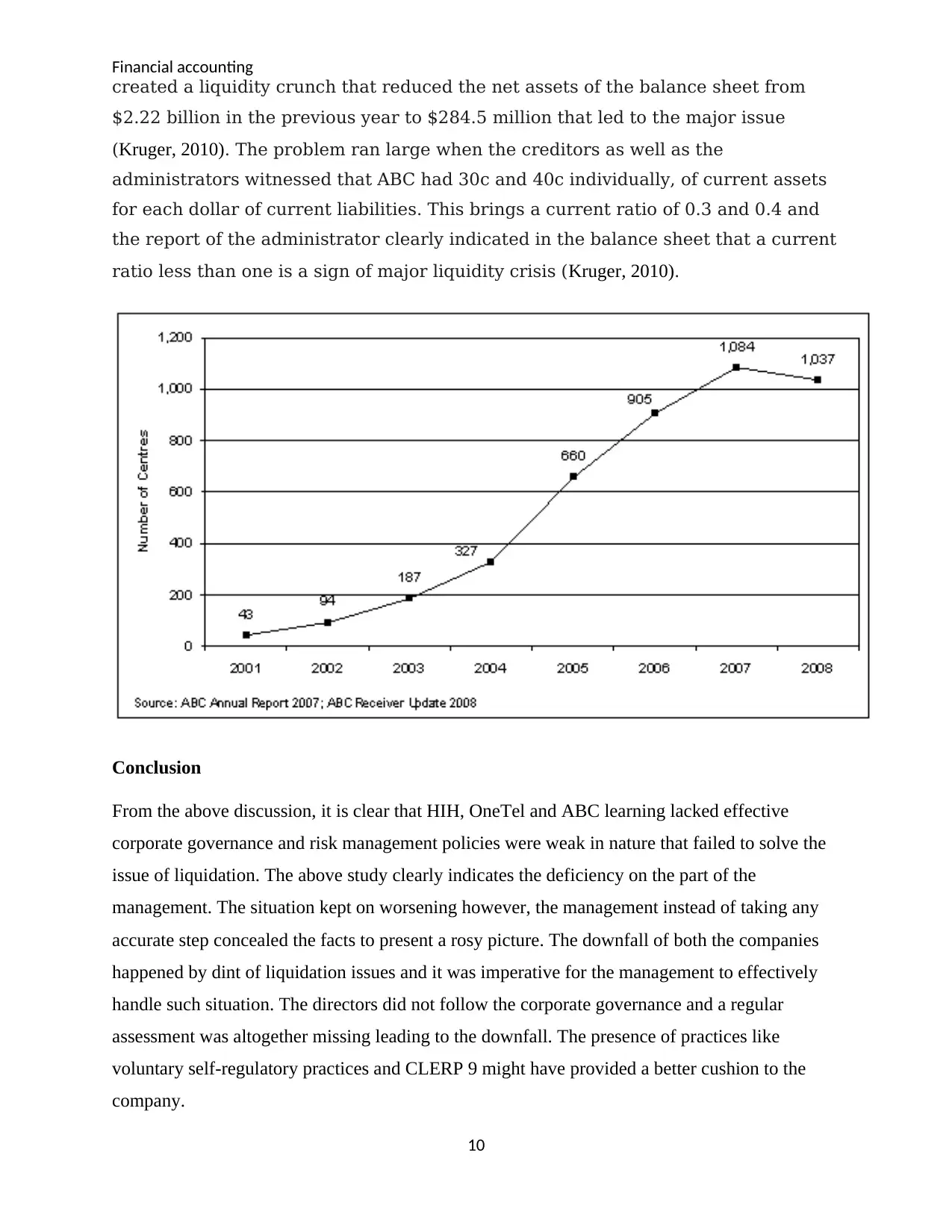
Financial accounting
created a liquidity crunch that reduced the net assets of the balance sheet from
$2.22 billion in the previous year to $284.5 million that led to the major issue
(Kruger, 2010). The problem ran large when the creditors as well as the
administrators witnessed that ABC had 30c and 40c individually, of current assets
for each dollar of current liabilities. This brings a current ratio of 0.3 and 0.4 and
the report of the administrator clearly indicated in the balance sheet that a current
ratio less than one is a sign of major liquidity crisis (Kruger, 2010).
Conclusion
From the above discussion, it is clear that HIH, OneTel and ABC learning lacked effective
corporate governance and risk management policies were weak in nature that failed to solve the
issue of liquidation. The above study clearly indicates the deficiency on the part of the
management. The situation kept on worsening however, the management instead of taking any
accurate step concealed the facts to present a rosy picture. The downfall of both the companies
happened by dint of liquidation issues and it was imperative for the management to effectively
handle such situation. The directors did not follow the corporate governance and a regular
assessment was altogether missing leading to the downfall. The presence of practices like
voluntary self-regulatory practices and CLERP 9 might have provided a better cushion to the
company.
10
created a liquidity crunch that reduced the net assets of the balance sheet from
$2.22 billion in the previous year to $284.5 million that led to the major issue
(Kruger, 2010). The problem ran large when the creditors as well as the
administrators witnessed that ABC had 30c and 40c individually, of current assets
for each dollar of current liabilities. This brings a current ratio of 0.3 and 0.4 and
the report of the administrator clearly indicated in the balance sheet that a current
ratio less than one is a sign of major liquidity crisis (Kruger, 2010).
Conclusion
From the above discussion, it is clear that HIH, OneTel and ABC learning lacked effective
corporate governance and risk management policies were weak in nature that failed to solve the
issue of liquidation. The above study clearly indicates the deficiency on the part of the
management. The situation kept on worsening however, the management instead of taking any
accurate step concealed the facts to present a rosy picture. The downfall of both the companies
happened by dint of liquidation issues and it was imperative for the management to effectively
handle such situation. The directors did not follow the corporate governance and a regular
assessment was altogether missing leading to the downfall. The presence of practices like
voluntary self-regulatory practices and CLERP 9 might have provided a better cushion to the
company.
10
Paraphrase This Document
Need a fresh take? Get an instant paraphrase of this document with our AI Paraphraser
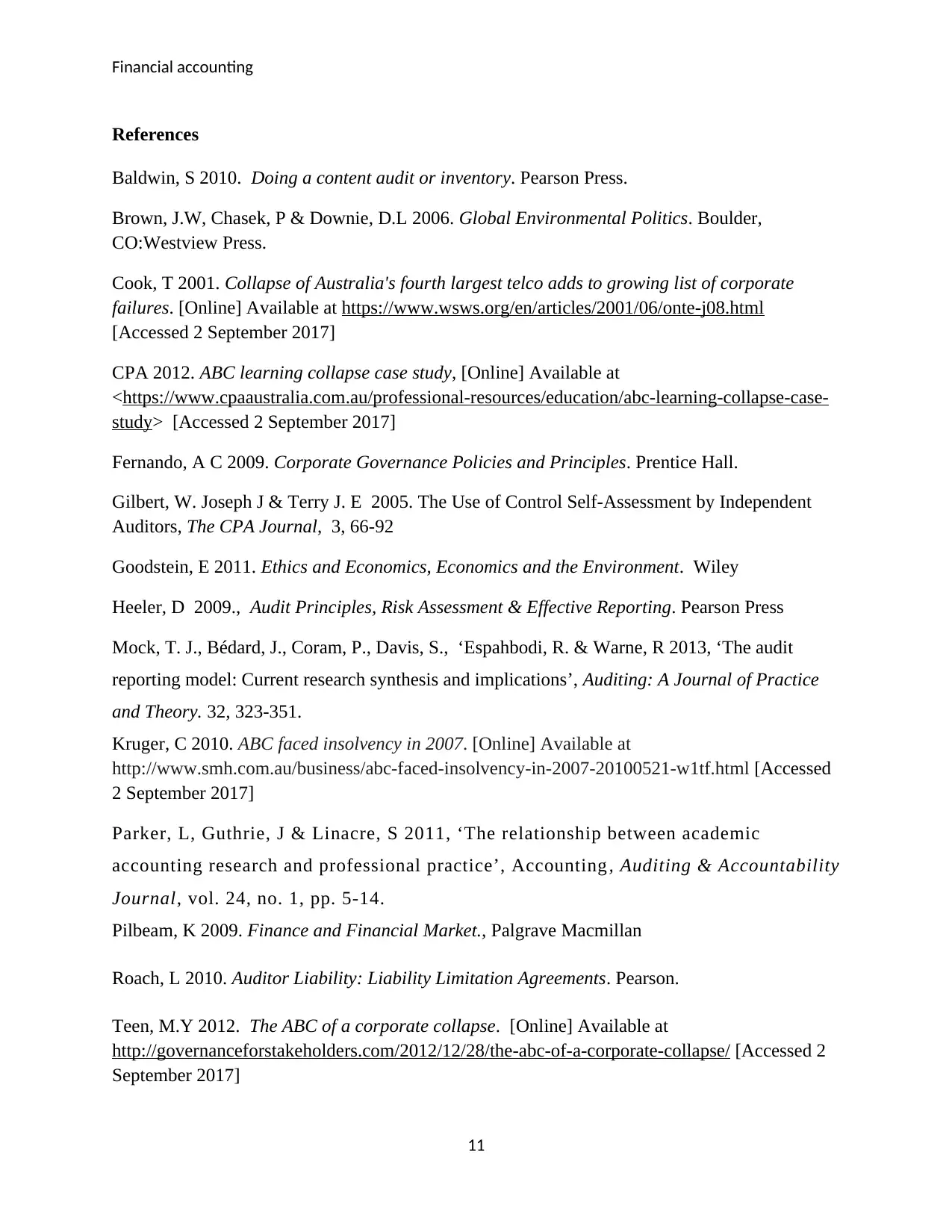
Financial accounting
References
Baldwin, S 2010. Doing a content audit or inventory. Pearson Press.
Brown, J.W, Chasek, P & Downie, D.L 2006. Global Environmental Politics. Boulder,
CO:Westview Press.
Cook, T 2001. Collapse of Australia's fourth largest telco adds to growing list of corporate
failures. [Online] Available at https://www.wsws.org/en/articles/2001/06/onte-j08.html
[Accessed 2 September 2017]
CPA 2012. ABC learning collapse case study, [Online] Available at
<https://www.cpaaustralia.com.au/professional-resources/education/abc-learning-collapse-case-
study> [Accessed 2 September 2017]
Fernando, A C 2009. Corporate Governance Policies and Principles. Prentice Hall.
Gilbert, W. Joseph J & Terry J. E 2005. The Use of Control Self-Assessment by Independent
Auditors, The CPA Journal, 3, 66-92
Goodstein, E 2011. Ethics and Economics, Economics and the Environment. Wiley
Heeler, D 2009., Audit Principles, Risk Assessment & Effective Reporting. Pearson Press
Mock, T. J., Bédard, J., Coram, P., Davis, S., ‘Espahbodi, R. & Warne, R 2013, ‘The audit
reporting model: Current research synthesis and implications’, Auditing: A Journal of Practice
and Theory. 32, 323-351.
Kruger, C 2010. ABC faced insolvency in 2007. [Online] Available at
http://www.smh.com.au/business/abc-faced-insolvency-in-2007-20100521-w1tf.html [Accessed
2 September 2017]
Parker, L, Guthrie, J & Linacre, S 2011, ‘The relationship between academic
accounting research and professional practice’, Accounting , Auditing & Accountability
Journal, vol. 24, no. 1, pp. 5-14.
Pilbeam, K 2009. Finance and Financial Market., Palgrave Macmillan
Roach, L 2010. Auditor Liability: Liability Limitation Agreements. Pearson.
Teen, M.Y 2012. The ABC of a corporate collapse. [Online] Available at
http://governanceforstakeholders.com/2012/12/28/the-abc-of-a-corporate-collapse/ [Accessed 2
September 2017]
11
References
Baldwin, S 2010. Doing a content audit or inventory. Pearson Press.
Brown, J.W, Chasek, P & Downie, D.L 2006. Global Environmental Politics. Boulder,
CO:Westview Press.
Cook, T 2001. Collapse of Australia's fourth largest telco adds to growing list of corporate
failures. [Online] Available at https://www.wsws.org/en/articles/2001/06/onte-j08.html
[Accessed 2 September 2017]
CPA 2012. ABC learning collapse case study, [Online] Available at
<https://www.cpaaustralia.com.au/professional-resources/education/abc-learning-collapse-case-
study> [Accessed 2 September 2017]
Fernando, A C 2009. Corporate Governance Policies and Principles. Prentice Hall.
Gilbert, W. Joseph J & Terry J. E 2005. The Use of Control Self-Assessment by Independent
Auditors, The CPA Journal, 3, 66-92
Goodstein, E 2011. Ethics and Economics, Economics and the Environment. Wiley
Heeler, D 2009., Audit Principles, Risk Assessment & Effective Reporting. Pearson Press
Mock, T. J., Bédard, J., Coram, P., Davis, S., ‘Espahbodi, R. & Warne, R 2013, ‘The audit
reporting model: Current research synthesis and implications’, Auditing: A Journal of Practice
and Theory. 32, 323-351.
Kruger, C 2010. ABC faced insolvency in 2007. [Online] Available at
http://www.smh.com.au/business/abc-faced-insolvency-in-2007-20100521-w1tf.html [Accessed
2 September 2017]
Parker, L, Guthrie, J & Linacre, S 2011, ‘The relationship between academic
accounting research and professional practice’, Accounting , Auditing & Accountability
Journal, vol. 24, no. 1, pp. 5-14.
Pilbeam, K 2009. Finance and Financial Market., Palgrave Macmillan
Roach, L 2010. Auditor Liability: Liability Limitation Agreements. Pearson.
Teen, M.Y 2012. The ABC of a corporate collapse. [Online] Available at
http://governanceforstakeholders.com/2012/12/28/the-abc-of-a-corporate-collapse/ [Accessed 2
September 2017]
11
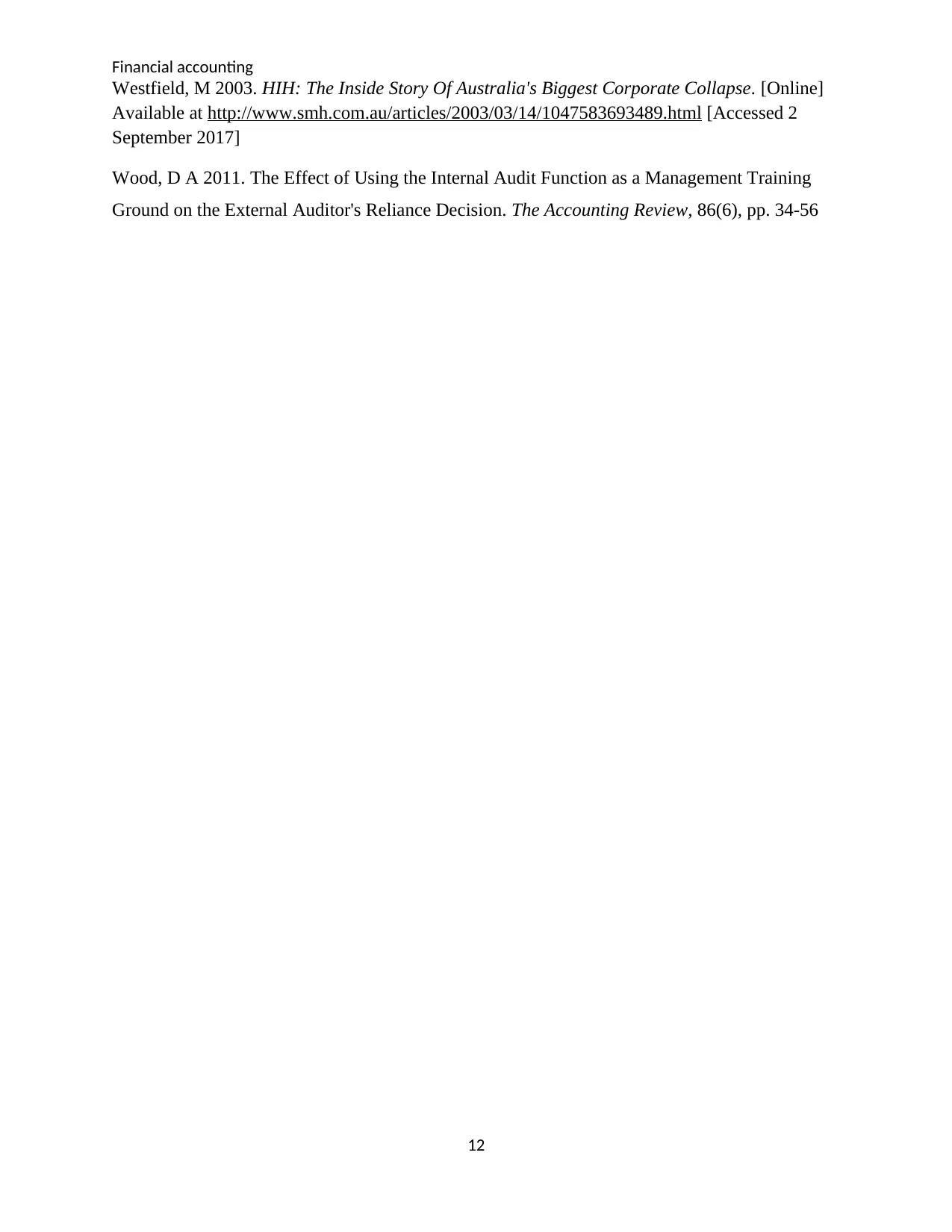
Financial accounting
Westfield, M 2003. HIH: The Inside Story Of Australia's Biggest Corporate Collapse. [Online]
Available at http://www.smh.com.au/articles/2003/03/14/1047583693489.html [Accessed 2
September 2017]
Wood, D A 2011. The Effect of Using the Internal Audit Function as a Management Training
Ground on the External Auditor's Reliance Decision. The Accounting Review, 86(6), pp. 34-56
12
Westfield, M 2003. HIH: The Inside Story Of Australia's Biggest Corporate Collapse. [Online]
Available at http://www.smh.com.au/articles/2003/03/14/1047583693489.html [Accessed 2
September 2017]
Wood, D A 2011. The Effect of Using the Internal Audit Function as a Management Training
Ground on the External Auditor's Reliance Decision. The Accounting Review, 86(6), pp. 34-56
12
⊘ This is a preview!⊘
Do you want full access?
Subscribe today to unlock all pages.

Trusted by 1+ million students worldwide
1 out of 12
Related Documents
Your All-in-One AI-Powered Toolkit for Academic Success.
+13062052269
info@desklib.com
Available 24*7 on WhatsApp / Email
![[object Object]](/_next/static/media/star-bottom.7253800d.svg)
Unlock your academic potential
Copyright © 2020–2025 A2Z Services. All Rights Reserved. Developed and managed by ZUCOL.





